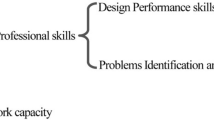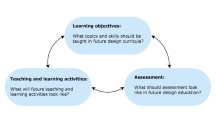Abstract
Top 10 Italy design institutes proposed by “Domus” white paper were taken as original research data to study the influence of different factors on design education orientation in this work. SPSS statistic tool was employed to analyze the internal dependencies between different factors based on the factor analysis method. The results suggest that three potential common factors including the potential market scientific research factor, existing market scientific research factor and market development space of the major factor can be regarded as the main factors affecting design education orientation.
You have full access to this open access chapter, Download conference paper PDF
Similar content being viewed by others
Keywords
1 Introduction
European and American system are the two main international design education systems currently [1]. Among them, European system, which derived from long-term social and cultural development, mainly focusing on improving problem-solving ability to conduct the market demand. On the contrary, American system was formed basing on the economic development and belonged to the business-driven mode. Although the two systems show difference, both of them are succeed in cultivating qualified designers [2].
Differing from the two education systems mentioned above, design education in China mainly followed German Bauhaus design mode founded at the beginning of last century, which obviously cannot match with the demand of society and economy development. Given this situation, design education reform in China is necessary and learning from the two systems can be the most effective approach.
Referring to the design institutes carried out under the two systems, it can be clearly noticed that variation on subject orientation eventually resulted in the significant difference on education modes and structures. As to the subject orientation, investigation on the top 50 design institutes in Europe suggested that factors including teaching languages, business partners, existing laboratory construction et al. showed great impact on design education orientation [3]. However, the effect of such factors on the subject orientation is rather difficult to evaluate, due to complex interactions between different factors. Understanding the effect of factors on the subject orientation and adjusting the education structure so as to improve the discipline competitive ability is therefore a very important issue.
The purpose of this work was to study the influence factors affecting design education orientation. To realize this objective, the representative top 10 Italy design institutes proposed by “Domus” white paper were taken as survey objects for factor selection. Further, factors selected were analyzed using SPSS statistics tool based on the factor analysis method.
2 Data Sources and Research Method
2.1 Data Sources
As mentioned above, design education subject orientation can be affected by series of factors. In this work, the representative top 10 Italy design institutes proposed by “Domus” white paper published in recent two years were taken as the original data sources for factor selection.
A total of eight high-frequency vocabularies presented in the white paper were selected as main factors including five quantitative indexes and three qualitative indexes. That is, design student enrollment number for X1, teaching language for X2, business partners for X3, intercollegiate partners for X4, the number of majors for X5, the existing laboratory construction for X6, scientific experiment research for X7 and design theory research for X8. In order to achieve the quantitative analysis for the last three factors, questionnaire survey to 20 persons who are engaged in design education and have Italy design education background has been performed.
2.2 Research Method
The internal dependencies between different factors extracted from questionnaire were analyzed using SPSS statistics tool based on the factor analysis method [4]. The expression of this method is given by
where \( X = (X_{ 1} ,\,X_{ 2} ,\, \cdots ,\,X_{\text{p}} )^{\prime},\,F = (F_{ 1} ,\;F_{ 2} ,\, \cdots ,\,F_{\text{k}} )^{\prime} \) and ε represent the factor, common factor and specific factor, respectively. A is the component matrix. As shown above, the most information of the original data can be reflected using few variables.
3 Results and Discussions
To verify the reliability of the data, factor correlation matrix has been calculated through SPSS software, and the results are listed in Table 1.
From Table 1, it can be seen that most of the correlation coefficients are higher than 0.3 indicating that original data are suitable for factor analysis. Moreover, KMO and Barlett tests have also been carried out, the KMO value of 0.678 and lower values of Bartlett sphericity test Sig. than 0.05 also verified the realibility of the data obtained in this work.
On this basis, the variances of the data have been analyzed using SPSS to determine the numbers of common factors. The results shows that there are 3 factors with eigenvalue more than 1, and the corresponding cumulative contribution rate is 87.08 %. The number for common factors can then be confirmed to be 3. That is, there are 3 main factors show impact on design education subject orientation. Further, to understand the meaning of the 3 common factors, orthogonal rotation was performed on factor loading matrix. Three main common factors are presented in the data. The three potential common factors can be inducted by the potential market scientific research factor, existing market scientific research factor and market development space of the major factor, respectively. Among them, the potential market scientific research factor mainly includes two aspects: research on design theory and frontier technologies. The second factor represents the ability of solving practical problems on present commercial market. With regard to the third factor, it requires the sound judgement for the market developing status and trend. From the Fig. 1 below, factors accumulate into 3 clusters.
4 Conclusion
In this work, influence of different factors on design education orientation have been investigated. Top 10 Italy design institutes proposed by “Domus” white paper were taken as survey objects for preliminary factor selection. Further, SPSS statistics tool was empolied to analyze the internal dependencies between different factors based on the factor analysis method. Based on the results, three common factors including the potential market scientific research factor, existing market scientific research factor and market development space of the major factor can be determined. The combination effect of the 3 common factors can be used for the subject orientation on the early stage.
References
Nigel, C.: Engineering Design Methods: Strategies for Product Design, 4th edn. Wiley, Chichester (2008)
Hertenstein, J.H., Platt, M.B., Veryzer, R.W.: The impact of industrial design effectiveness on corporate financial performance. J. Prod. Innov. Manag. 1(22), 3–21 (2005)
Domus book. http://digitaledition.domusweb.it/domus/books/131201domus/#/9/
Bruce, T.: Exploratory and Confirmatory Factor Analysis: Understanding Concepts and Applications. American Psychological Association, Washington, D.C. (2004)
Acknowledgments
We thank the financial support by “the Fundamental Research Funds for the Central Universities” (No. 2222014010), the “Chen Guang” Project supported by Shanghai Municipal Education Commission and Shanghai Education Development Foundation (No. 13CG67).
Author information
Authors and Affiliations
Editor information
Editors and Affiliations
Rights and permissions
Copyright information
© 2015 Springer International Publishing Switzerland
About this paper
Cite this paper
Zhang, Z., Cheng, J., Yang, C. (2015). Research on Influence Factors of Design Education Orientation-Taking Italian Design Education as an Example. In: Stephanidis, C. (eds) HCI International 2015 - Posters’ Extended Abstracts. HCI 2015. Communications in Computer and Information Science, vol 528. Springer, Cham. https://doi.org/10.1007/978-3-319-21380-4_77
Download citation
DOI: https://doi.org/10.1007/978-3-319-21380-4_77
Publisher Name: Springer, Cham
Print ISBN: 978-3-319-21379-8
Online ISBN: 978-3-319-21380-4
eBook Packages: Computer ScienceComputer Science (R0)






